 |
| California strawberry field ca. 1985. Photo credit: Orange County Archives. |
Although they grow wild across the globe, and can today be found in supermarkets nearly year round, strawberries weren't always so easy to come by. From 1908 to 1922, the word "strawberry" returns over 137,000 newspaper records in the Library of Congress' digitized newspaper collection, but the fourteen year increment from 1836 to 1850 returns just 2590. One newspaper reported strawberries in Brooklyn, NY cost fifty cents each in 1887; this would be over thirteen dollars today. The storied history of the modern strawberry involves royalty, international travel, and even a French spy.
Fragaria vesca, a European species, may have been the first domesticated strawberry in the world. Cultivated by Romans and Greeks, the French began growing F. vesca in their gardens by the 1300s.
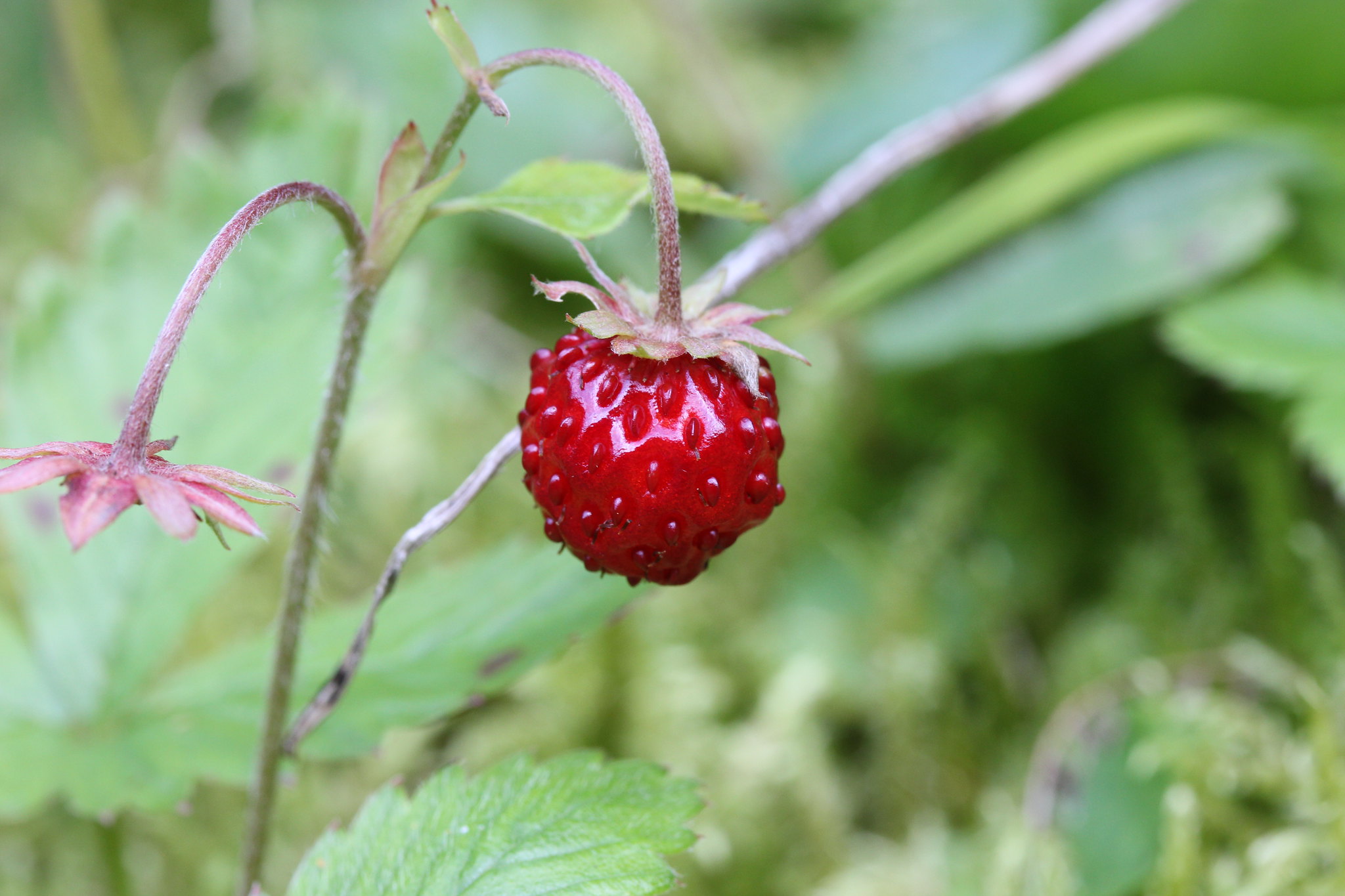 |
| F. vesca fruit. Photo credit: Björn S.... |
About two hundred years later, the wild North American species F. virginiana was introduced to Europe by Jacques Cartier (explorer who discovered the St. Lawrence river in 1523) and gained a following there (although another source dates its introduction to France to 1624 and Darrow (1966) states little is known about how F. virginiana arrived in Europe except that it probably crossed the Atlantic in the early 1500s). At the end of the sixteenth century, F. vesca and F. moschata dominated gardens; there was also a third known species, F. viridis, commonly known as the green strawberry.
_Dragon-fly_moths_spider_beetles_with_strawberries.jpg/1920px-Jan_van_Kessel_(I)_Dragon-fly_moths_spider_beetles_with_strawberries.jpg) |
| A Dragon-fly, Two Moths, a Spider and Some Beetles, With Wild Strawberries by Jan van Kessel, 17th century. Image credit: Wikipedia. |
 |
| F. virginiana, North American wild strawberry. Photo credit: Wisconsin Department of Natural Resources. |
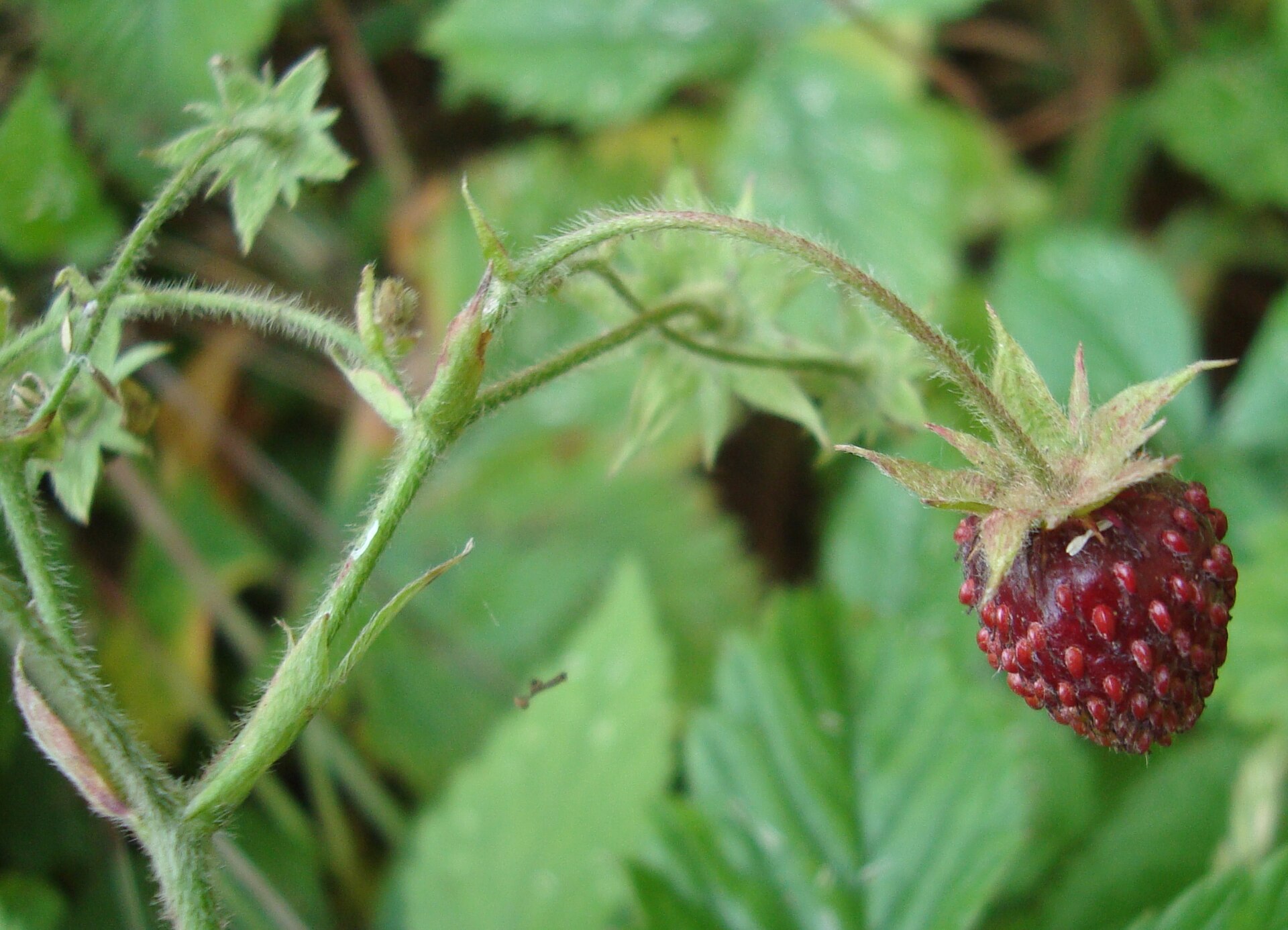 |
| F. moschata, native to Europe. Photo credit: Dendrofil. |
At least a century later, French engineer and spy Amédée-François Frézier was mapping Spanish forts in Chile when he noticed F. chiloensis, a wild species known for its large fruit, and brought five specimens back to France in 1714. The voyage around Cape Horn took six months, and the plants had to be watered and cared for throughout the journey amidst freshwater rationing.
-
Some side notes:
After completing his studies, but before leaving for South America, Frézier visited Italy and grew fascinated by art and architecture. He wrote a book synthesizing what was known about fireworks and how to make them artistic displays in an era where pyrotechnics had focused solely on military uses. The book became an authority on the subject and garnered him a promotion.
The Mapuche and Huilliche tribes that lived in F. chiloensis' Chilean habitat were probably first to cultivate it because their languages contain words to distinguish wild strawberry from cultivated. Darrow (1966) states that these tribes were cultivating strawberry at least as long as Europeans.
Frézier had named the Chilean strawberry F. chiliensis in reference to Chile, but Linnaeus later renamed it F. chiloensis.
-
 |
| A map of coastal Chile and Peru drawn by Frézier in the early 1700s. He also drew a map of Concepción where he found the Chilean strawberries. Image credit: Wikipedia. |
 |
| An illustration of F. chiloensis in Frézier's book documenting his travels, published in the early 1700s. Frézier wrote to Duchesne (more on him below) in 1765 that "For half a real, which is the lowest money, one gets one or two dozens, wrapped in a cabbage leaf." Image credit: Wikipedia. |
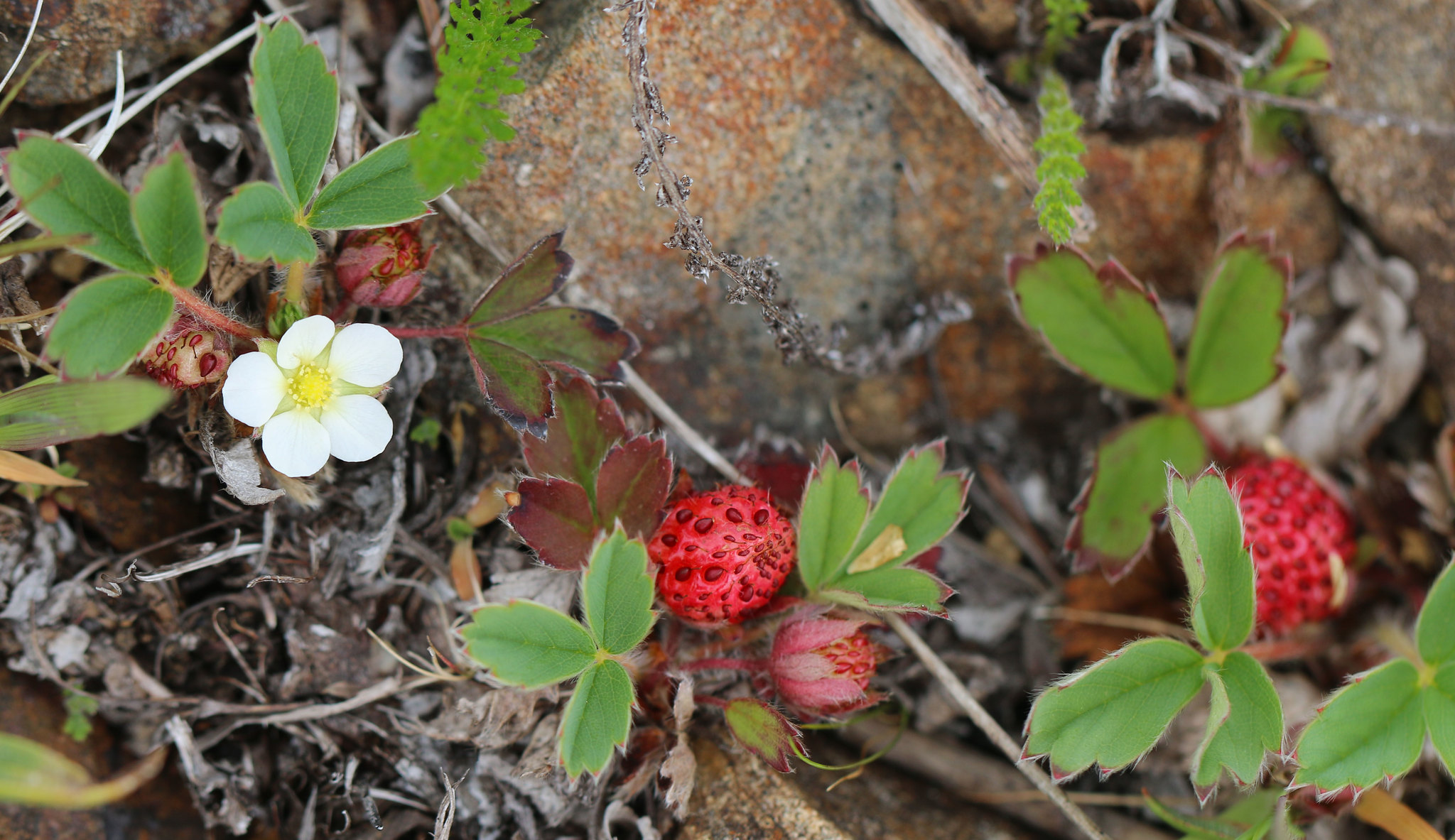 |
| Fragaria chiloensis, coastal strawberry native to Chile. Photo credit: Peter Pearsall, U.S. Fish and Wildlife Service. |
Frézier's plants did not bear fruit at first, disappointing French and English growers. French scholar Antoine Nicolas Duchesne (1747–1827) proved that some species of strawberry, like F. chiloensis, are dioecious, that is, male and female plants are required for fruit set, but only female plants of F. chiloensis had been imported. In 1764, when he was just seventeen, Duchesne brought King Louis XV a bowl of strawberries that he grew by pollinating F. chiloensis with pollen from F. moschata. Due to genetic differences in ploidy, perhaps not fully understood at the time, F. chiloensis would not cross with F. vesca.
Reports of different looking fruits began to surface in Brittany, where F. chiloensis was widely grown. In a book he published in 1766 when he was just nineteen years old, Duchesne posited the theory (later proven) that the unusual fruit were the result of F. virginiana and F. chiloensis hybridizing. He named the hybrid Fragaria x ananassa as a tribute to the fruit's pineapple-like fragrance (Ananas being the genus of pineapple). By the end of the 1800s, F. chiloensis had become less popular in favor of hybrids.
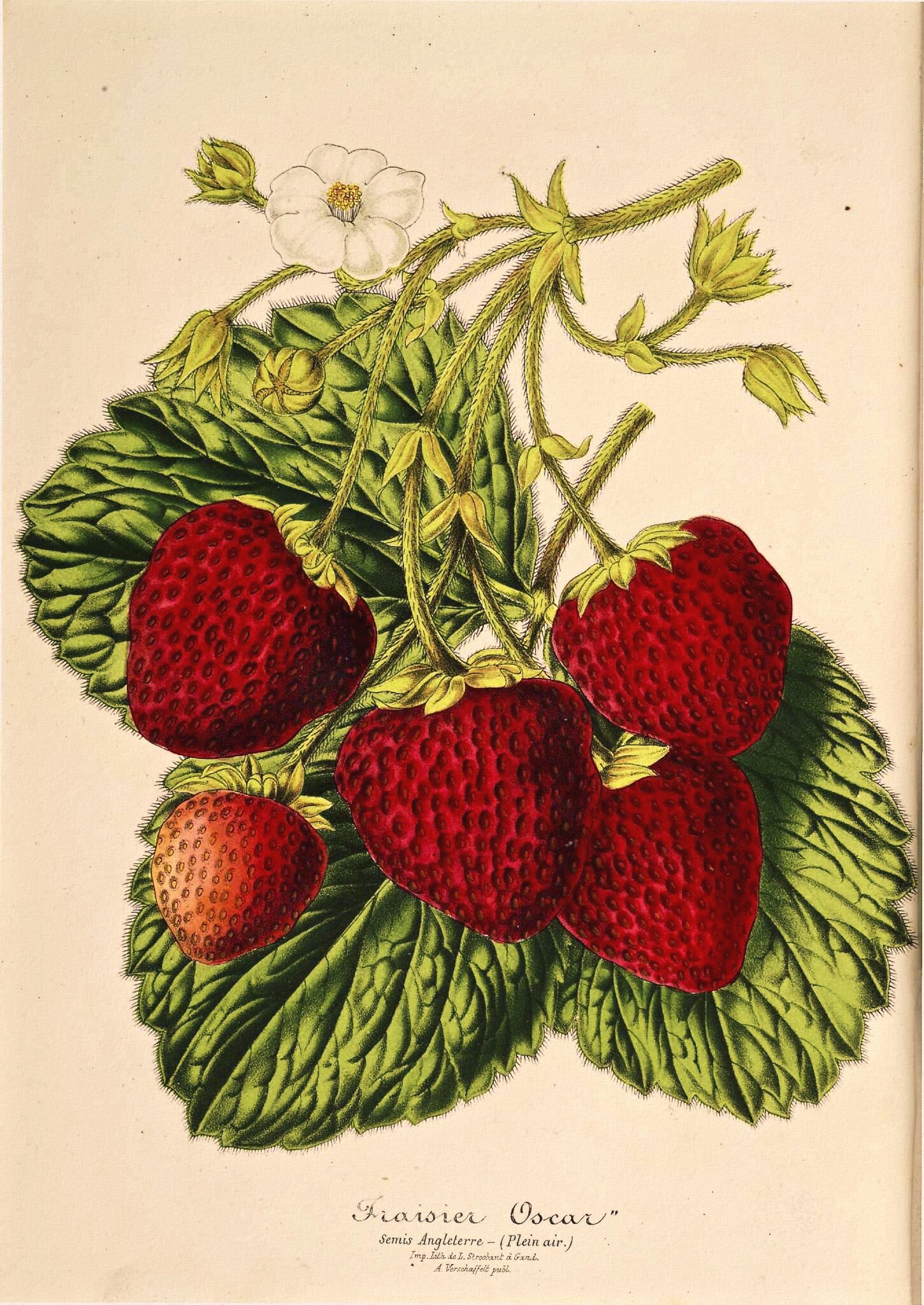 |
| Fragaria x ananassa var. Oscar circa 1870s. Image credit: Swallowtail Garden Seeds. |
Interestingly, both F. virginiana and F. chiloensis occurred in North America in the wild, but Native Americans do not appear to have cultivated them.
Getting from wild varieties to modern commercial cultivars is a lengthy process of which Duchesne's discovery of F. xananassa is only the first step. The offspring of the hybrids must then be hybridized and back-crossed to the parents for reselection (Darrow (1966)). France may have birthed the modern strawberry in the 1700s, but England can be credited with the earliest breeding work to improve it.
By 1824, the Royal Horticultural Society knew twenty-six varieties of F. virginiana, none surpassing the wild strawberry in flavor, and there were several known varieties of F. chiloensis in England as well (which were considered by the English inferior to F. virginiana). Thomas Andrew Knight is credited with being the first to undertake systematic breeding of the strawberry. Another Englishman, Michael Keens, who was also breeding strawberries back then, developed the Keens Seedling variety that Darrow (1966) described as "an ancestor of most of today's leading varieties".
In the early 1800s in the U.S., most of the strawberries grown were the native F. virginiana. Charles Hovey, a Massachusetts nurseryman and founder and long-time editor of what became Magazine of Horticulture, is credited with introducing one of the earliest popular cultivars in North America, aptly named 'Hovey', in 1836. By 1840, the Hovey commanded a tenth of strawberry fields, these mostly concentrated in New England.
The majority of strawberries in cultivation then were still native varieties, but in 1858, the introduction of the hardy Wilson variety by a Scottish New Yorker named John Wilson replaced native varieties and dramatically expanded the strawberry industry. Produced on roughly half the acreage dedicated to strawberries, the Wilson dominated the strawberry landscape in the latter half of the nineteenth century. Both the Wilson and Hovey resulted from growing out just one set of seedlings.
-
King Kamehameha IV of Hawaii, two years into his reign in 1857, invited readers of The Pacific Commercial Advertiser to his Nuuanu property to take home "the finest imported varieties" of strawberry, as his gardener was cleaning out the beds and they were about to be thrown out.
-
| 'Improved Wilson' ca. 1891. Image credit: U.S. Department of Agriculture Pomological Watercolor Collection. Rare and Special Collections, National Agricultural Library, Beltsville, MD 20705. |
Darrow (1966) included maps showing where popular strawberry varieties were grown in the nineteenth and twentieth centuries. In the first half of the 1800s, cultivation was largely limited to New England and native wild varieties. By the late 1800s, cultivation expanded to the Midwest and South, largely due to the Wilson variety.
Between 1900 and 1920, the Dunlap variety swathed across much of the northern U.S., 'Klondike' its southern counterpart. 'Gandy' dominated the Northeast and eastern Midwest, 'Aroma' spanned Nebraska to Tennessee, 'Jucunda' much of Colorado, and 'Marshall' the West Coast. Paintings of these varieties, except for Jucunda, done in this era exist as part of the U.S. Department of Agriculture (USDA) Pomological Watercolor Collection and are reproduced below. Links in each caption link back to the original record and image file on the USDA site. But first, an antique postcard of a Texas strawberry field:
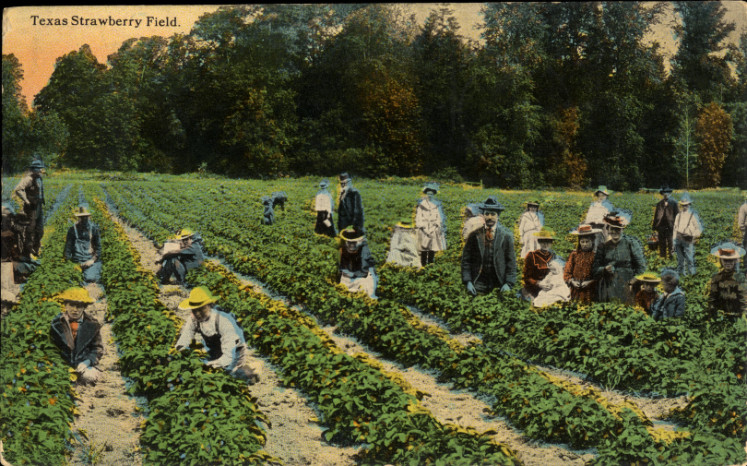 |
| Postcard depicting a Texas strawberry field ca. 1908-1910. Image credit: Wikipedia. |
| 'Dunlap' by Mary Daisy Arnold (1873-1955) in 1912. Image credit: U.S. Department of Agriculture Pomological Watercolor Collection. Rare and Special Collections, National Agricultural Library, Beltsville, MD 20705. |
| 'Klondike' by Mary Daisy Arnold (1873-1955) in 1915. Image credit: U.S. Department of Agriculture Pomological Watercolor Collection. Rare and Special Collections, National Agricultural Library, Beltsville, MD 20705. |
| 'Gandy' by Deborah Griscom Passmore (1840-1911) in 1906. Image credit: U.S. Department of Agriculture Pomological Watercolor Collection. Rare and Special Collections, National Agricultural Library, Beltsville, MD 20705. |
| 'Aroma' by Bertha Heiges in 1900. Image credit: U.S. Department of Agriculture Pomological Watercolor Collection. Rare and Special Collections, National Agricultural Library, Beltsville, MD 20705. |
| 'Marshall' by Bertha Heiges in 1904. Image credit: U.S. Department of Agriculture Pomological Watercolor Collection. Rare and Special Collections, National Agricultural Library, Beltsville, MD 20705. |
Darrow (1966) lists Marshall, Klondike, Dunlap, and Aroma (images above), as well as the Missionary, Howard 17, Aberdeen, Blakemore, and Fairfax, as the most important varieties of the first half of the twentieth century. The Blakemore and Fairfax were created by Darrow himself. Some of the highlights of these varieties were:
- Marshall
Well suited to West Coast conditions; replaced by varieties with greater disease resistance in the mid 1900s. - Klondike
A railroad shipping agent introduced this variety in 1901 after seeing the need for a strawberry that travels well; the leading variety for three decades until the Blakemore displaced it. Descends from a Hovey hybrid. - Dunlap
Known for hardiness, flavor, and vigor. - Aroma
Introduced in 1891 and a major variety between 1920 and 1940; good looking fruit, productive, and disease resistant. - Missionary
Requires less chilling and fruits better in semitropics. - Howard 17
Disease resistance and productivity are among its many positive traits; widely used in breeding. Its namesake Arthur B. Howard started systematically breeding strawberries in the late 1800s. - Aberdeen
High yields, good flavor, but did not ship well. - Blakemore
Cross of Missionary and Howard 17; ships well, disease resistant, more productive than Klondike, and ripens early. - Fairfax
Disease resistant and exceptional flavor.
| 'Missionary' by Mary Daisy Arnold (1873-1955) in 1915. Image credit: U.S. Department of Agriculture Pomological Watercolor Collection. Rare and Special Collections, National Agricultural Library, Beltsville, MD 20705. |
| 'Blakemore' ca. 1935. Image credit: U.S. Department of Agriculture Pomological Watercolor Collection. Rare and Special Collections, National Agricultural Library, Beltsville, MD 20705. |
| 'Fairfax', undated. Image credit: U.S. Department of Agriculture Pomological Watercolor Collection. Rare and Special Collections, National Agricultural Library, Beltsville, MD 20705. |
| 'Pocahontas' by Ellen Isham Schutt (1873-1955) in 1910. Image credit: U.S. Department of Agriculture Pomological Watercolor Collection. Rare and Special Collections, National Agricultural Library, Beltsville, MD 20705. |
Like evolving fashions, strawberry varieties are continuously being replaced by new and improved selections. Blakemore, for example, replaced Klondike in the mid 1930s, but was itself replaced by newer varieties like Sparkle and Pocahontas (above).
So what varieties are grown in commercial fields today? Bloomberg reported that American Driscoll's varieties are typically around for just three years. Each year, Driscoll's selects new plants from amongst thousands to develop into new varieties, a process that takes up to seven years. In 1991, Driscoll's had six of its forty-two patented varieties in commercial production.
Driscoll's does not release its patented varieties to other growers, and considers University of California (UC) Davis' strawberry breeding program its primary competition. The UC program, which originated at UC Berkeley in the 1920s, has been criticized with restricting access to its varieties and has been the focus of recent legal action. Strawberry varieties comprise four of the UC's top ten income generating inventions. The breeding program had a million dollar surplus last year, supporting a billion dollar California industry, but nearly shuttered a few years ago without explanation.
Below are a few more paintings from the late 1800s to early 1900s of perhaps rarer varieties from the USDA Pomological Watercolor Collection. Botanically accurate, it is worth comparing the finer details depicted in the paintings of the varieties in this collection as there are noticeable visual differences.
| Variety 'Timbrell', painted 1897. Image credit: U.S. Department of Agriculture Pomological Watercolor Collection. Rare and Special Collections, National Agricultural Library, Beltsville, MD 20705 |
| Variety 'Early Ozark', painted 1913. Image credit: U.S. Department of Agriculture Pomological Watercolor Collection. Rare and Special Collections, National Agricultural Library, Beltsville, MD 20705. |
| Variety 'George Washington', painted 1913. Image credit: U.S. Department of Agriculture Pomological Watercolor Collection. Rare and Special Collections, National Agricultural Library, Beltsville, MD 20705. |
Other sources and/or further information:
Perhaps the foremost modern authority on strawberries, The Strawberry by George M. Darrow (1966), available as PDF at https://specialcollections.nal.usda.gov/speccoll/collectionsguide/darrow/Darrow_TheStrawberry.pdf
USDA Pomological Watercolor Collection (also contains paintings of many other fruits, particularly apples)
https://usdawatercolors.nal.usda.gov/pom/about.xhtml
Big Bucks From Strawberry Genes Lead to Conflict at UC Davis (NPR The Salt, 2014)
http://www.npr.org/sections/thesalt/2014/07/02/327355935/big-bucks-from-strawberry-genes-lead-to-conflict-at-uc-davis
UC Davis Strawberry Breeding Program Historical Timeline
http://news.plantsciences.ucdavis.edu/2016/05/11/strawberry-breeding-program-backgrounder-a-historical-timeline/
A Patented Berry Has Sellers Licking Their Lips (NYTimes 1991)
http://www.nytimes.com/1991/10/14/us/a-patented-berry-has-sellers-licking-their-lips.html?pagewanted=all
How Driscoll's is Hacking the Strawberry of the Future (Bloomberg 2015)
http://www.bloomberg.com/news/features/2015-07-29/how-driscoll-s-is-hacking-the-strawberry-of-the-future
Sleuthing the Secrets to a Scrumptious Strawberry (2014)
http://blogs.scientificamerican.com/brainwaves/sleuthing-the-secrets-to-a-scrumptious-strawberry/
UC Davis strawberry breeding program under fire (The Californian 2015)
http://www.thecalifornian.com/story/money/2015/07/01/university-california-davis-california-strawberry-commission/29593819/
Strawberry ruling favors UC Davis (The Packer 2016)
http://www.thepacker.com/news/strawberry-ruling-favors-uc-davis
http://www.ars.usda.gov/is/kids/plants/story7/history.htm
http://naldc.nal.usda.gov/download/33602/PDF (PDF)
http://www.botgard.ucla.edu/html/botanytextbooks/economicbotany/Fragaria/index.html
List of Fragaria species from The Plant List:
http://www.theplantlist.org/tpl1.1/search?q=fragaria
https://www.vitalberry.eu/pineberries/

No comments:
Post a Comment